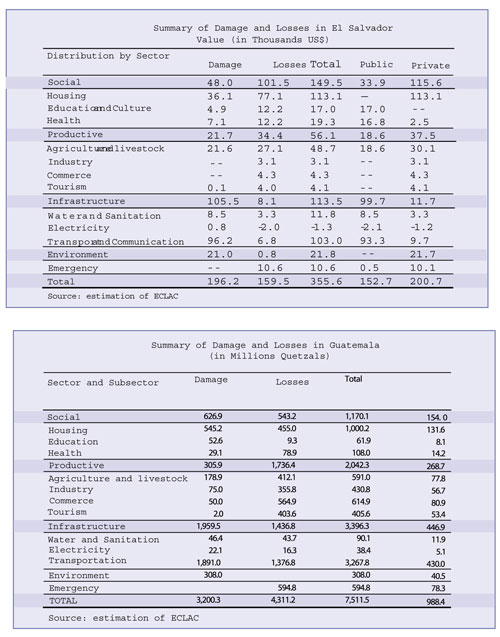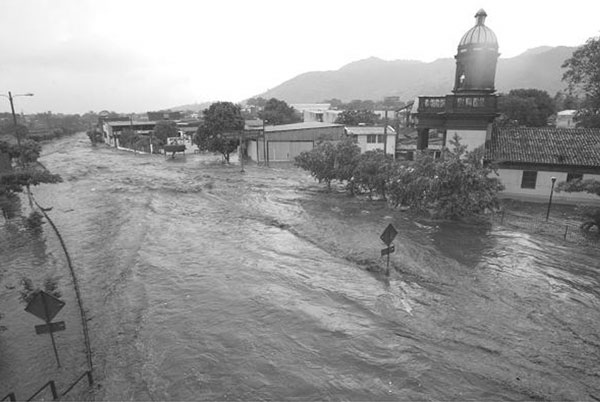

Latin America and the Caribbean
 |
 |
| International
Strategy for Disaster Reduction Latin America and the Caribbean |
Newsletter
ISDR Inform - Latin America and the Caribbean |
 |
|
Disasters
and hazards in the Region
|
| ECLAC The effects of hurricane Stan in El Salvador and Guatemala
The impact of this regional disaster that affected El Salvador and Guatemala as well as Mexico in a violent and tragic way also had local consequences. Therefore, the recovery must be seen on at least three levels:
vulnerability reduction will be accelerated and synergized if there is regional cooperation. Two areas stand out as priorities: the shared and cooperative management of biosystems that include communities, resources and similar structures– such as territorial management, particularly of watersheds– and the potential to reduce the financial cost and the resources necessary to reduce risk. The latter refers to the need to value environmental management as a strategic element for risk reduction, and to place a value on environmental services as an alternative source of income for populations located in these fragile and degraded biosystems where typical productive activities deplete environmental resources and threaten their sustainability. Leveraging financial resources – not only as anti-cyclical instruments in the face of the costs of future emergencies – will facilitate the mobilization of the resources and investment necessary to carry out ambitious, multi-national risk reduction initiatives. This requires strengthening and promoting financial instruments that are negotiable in international markets. The participation of local communities affected by a disaster is necessary in these processes because of the diversity of their ethnic groups and cultures, gender differences, etc. The following can be stated about the effects of Hurricane Stan: a) Stan was a relatively “extreme” event
that added to the seasonal rains, which in this case aggravated the
recurring
effects
in all affected areas. The landslides in the highlands and floods on
the coast reveal the existing level of vulnerability as a result of
inappropriate management of watersheds, the use of mountainsides for
agricultural production and deforestation, and prior to the disaster,
human development and poverty rates below the national average; |
 |
While the need for risk management has been recognized for quite some time - given the multiple meteorological, seismic, and geological hazards in El Salvador and Guatemala – more solid and lasting risk management and reduction policies are required. The social impact, the greatest in quantitative terms, also has a qualitative impact on different population sectors, particularly the most vulnerable groups: the rural population, campesino women, and small businesses whose “backyard” economy suffered damages and losses that may not highly visible but have negative consequences for their well-being. The social impact will aggravate existing tendencies in the economy and will hinder improvements to the human development index, drive up dependence on remittances, and lead to negative consequences for the social fabric: migration, marginalization, and social pressure that affect public safety and security. 1 The ECLAC evaluation
mission was requested by the Ministry of Planning of Guatemala (SEGEPLAN).
The government appointed economist Gert Rosenthal
to support the national team and facilitate the work done in the context
of this evaluation. The team received support from various U.N. agencies
(FAO, UNFPA, ILO, PAHO/WHO, IOM, UNICEF, and UNDP), the World Bank, the
International Monetary Fund (IMF) and the Inter-American Development
Bank (IADB). The team also received the support of experts from various
government ministries and the Inter-Institutional Indigenous Coordination
Agency. The President’s Ministry of Women provided input on gender
issues. The team also received input from the business sector and private
sector associations. |
 |
| © UN/ISDR |